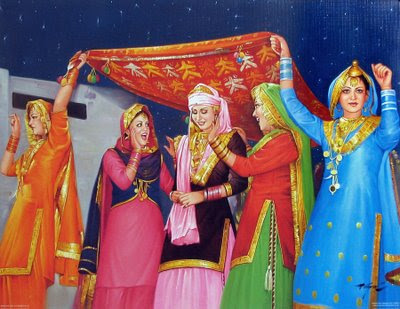Mehndi
From Wikipedia, the free encyclopedia
For other uses, see Mehndi (disambiguation).
Mehndi applied on a palm.
A Henna or Mehndi applier at work in Rishikesh, India.
Mehndi (Hindi: मेहँदी) is the application of henna as a temporary form of skin decoration in India, as well as by expatriate communities from the country. The word mehendi is derived from Sanskrit word mehaghni, which is also a synonym for turmeric (haldi in Hindi, haridra in Sanskrit). The use of mehndi and turmeric is described in the earliest Vedic ritual books. Turmeric as well as mehndi are important in Vedic customs as a symbolic representation of the Outer and the Inner Sun. Vedic customs are meant to awaken the "inner light and so the gold of the inner Sun has an important symbolic function.
Traditional mehndi designs draw the sun on the palm, which in this context represents the mind. Mehndi decorations became fashionable in the West in the late 1990s, where they are sometimes called henna tattoos. Henna is typically applied during special occasions like weddings and Hindu festivals like Karva Chauth, Diwali, Bhaidooj and Teej. In some Hindu festivals, every woman tries to have Henna done on her hands and feet. It is usually drawn on the palms and feet, where the color will be darkest because the skin contains higher levels of keratin which binds temporarily to lawsone, the colorant of henna. Henna was originally used as a form of decoration mainly for brides.
In the modern age, usually people buy readymade Henna cones, which are ready to use and make painting easy. However, in rural areas in India, women grind fresh henna leaves on sil (grinding stone) with added oil, which though not as refined as professionally prepared henna cones, brings much darker colors.
The term henna tattoo is figurative, because true tattoos are permanent surgical insertions of pigments underneath the skin, as opposed to pigments resting on the surface as is the case with mehndi.
Likely due to the desire for a "tattoo-black" appearance, many people have started adding the synthetic dye p-Phenylenediamine (PPD) to henna to give it a black colour. PPD is extremely harmful to the skin and can cause severe allergic reactions resulting in permanent injury or death.[1][2] Alata (Mahur) is a flower-based dye used to paint the feet of the brides in some regions of India. It is still used in Bengal.[clarification needed]
our punjabi weddings
Friday, 10 June 2011
punjabi weddings
Punjabi wedding traditions
From Wikipedia, the free encyclopedia
Jump to: navigation, search
Punjabi wedding traditions and ceremonies are traditionally conducted in Punjabi and are a strong reflection of Punjabi culture.
The actual religious marriage ceremony - among Sikhs, the weddings are conducted in Punjabi; among Muslims, in Urdu; and among Hindus, in Sanskrit. There are commonalities in ritual, song, dance, food, and dress. The Punjabi wedding has many rituals and ceremonies that have evolved since traditional times, including many famous Punjabi dances.
Contents
[hide]
1 Important wedding songs
2 Wedding rituals
3 References
4 See also
[edit] Important wedding songs
Songs of the bridegroom's side
Mangane di geet: sung at the time of engagement
Maneve de gaon: songs sung to welcome the bridegroom
Gharouli de geet: sung for the gharoult or dowry
Chounki charanvele de geet: songs sung when the bridegroom sits on the chounki wooden bathing seat
Sohhle: songs of happiness and joy
Ghoriyaan: sung at the time of riding to the bride's house
Sehra: sung at the time of tying the bridegrooms flower-veil
Kangana: sung when the bride and bridegroom enter the house together for the first time.
Songs of the bride's side
Suhag: which is sung by the bride in praise of her parents and the happy days of her childhood and in anticipation of happy days ahead.
Jaggo: procession song to call the neighbours to the wedding.
Churra charan vele da geet: sung when the chura, ceremonial bangles are worn by the bride.
Janj: sung when the janj, marriage procession, is to be greeted.
Milni: sung at the ritual introduction of the two sides.
Ghenne de geet: sung when the bride is adorned with jewels.
Siftan: song in praise of the bridegroom
Chhandh: evolved from poetry, songs of joy.
Sitthniyan (crude, teasing songs)
Song sung when the bridegroom's procession is being welcomed.
Song sung when the wari, or gifts from the bridegroom’s side, are being exhibited.
Song sung when the groom's party sits down to the meal.
Song sung when the daaj, dowry or the bridal gifts, are being displayed.
Subscribe to:
Posts (Atom)

